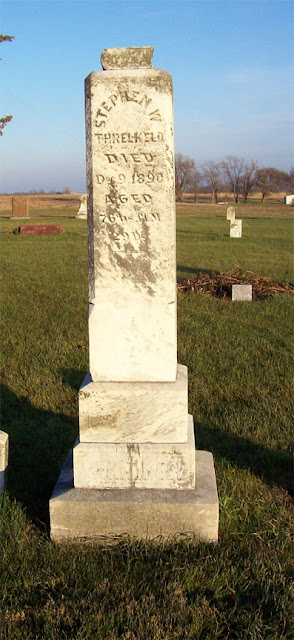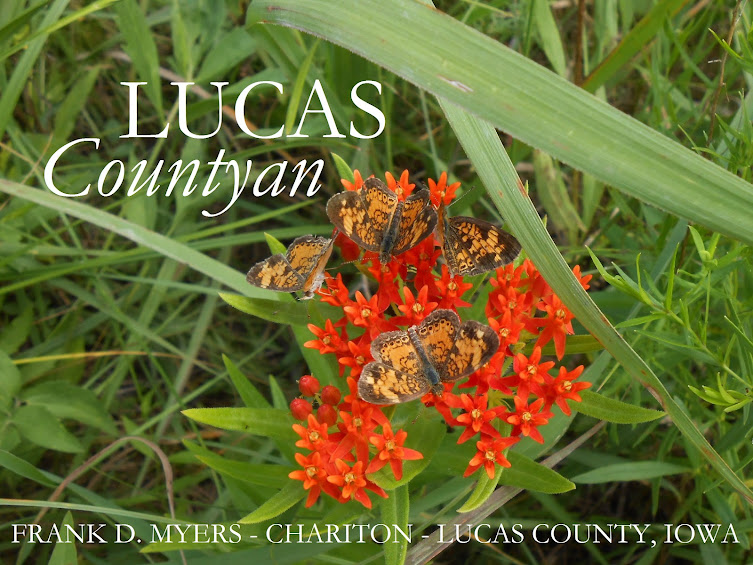I'm grateful to Scott Threlkeld, who about a month ago shared these wonderful portraits of his ancestors, Stephen Weakley and Susannah (Holeman) Threlkeld, patriarch and matriarch of one branch of Lucas County's extensive --- and widely known --- Threlkeld family.
You really do need a guide book to sort the Threlkelds, many of whom settled during the 1850s east of Chariton in a three-mile stretch along what now is U.S. Highway 34 commencing at the top of the hill just east of the current fence line of Red Haw State Park.
But all descended from Moses Threlkeld (1777-1845) and his wife, Elizabeth Weakley (1781-1874), Virginia natives who lived in Shelby County, Kentucky, before settling in Jackson County, Indiana, where Moses died. They had 13 children, including Stephen (born Dec. 13, 1813, in Kentucky). Stephen brought his young family to Lucas County during early 1855 from Warren County, Illinois, accompanied by his widowed mother, Elizabeth, and other kinfolk.
Several other children of Moses and Elizabeth either preceded or followed the 1855 party into Lucas County, including Washington Threlkeld (1803-1860), Patsy Threlkeld Wayland (1811-1896), Eliza Threlkeld Adams (1814-1897), Noah Threlkeld (1820-1882) and Sarah Threlkeld Davis (1822-1917).
The matriarch, Elizabeth (Weakley) Threlkeld, survived the trek to Lucas County by nearly 20 years, passing in 1874. She is buried in Ragtown Cemetery, southeast of Chariton in Benton Township, as are Stephen and Susannah and many of their relations. Later generations are buried in the Chariton Cemetery.
+++
Stephen's and Susannah's son, Isaac Newton Threlkeld (1852-1940), was three years old when he came west to Lucas County with his family and nearly 80 years later wrote a long and detailed account of his pioneer life as he and his wife, America "Mate" (Bryan) Threlkeld, were preparing to celebrate their 60th wedding anniversary. The entire account may be found here, in a post entitled
"Isaac N. Threlkeld has his say," but here are the paragraphs describing the 1855 journey west to Lucas County:
When I was about three years of age, my father traded an eighty acre Illinois farm for a tract of land in Lucas county. Here he decided to establish the family home at a time when this was considered the frontier. Consequently, in the latter part of January or the early part of February, 1855, two covered wagons started from our old home near Roseville, in Warren county, Illinois, on what, at that time, was a long, long journey. Some said it was "among the Indians," but there were no Indian camps in this immediate vicinity at the time. Not far to the west, however, there was an Indian settlement. I never learned just where it was located, but occasionally Indians came through this section.
The wagons in which we came west were the old fashioned, wide track, linch-pin wagons. They had no iron skeins with taps to hold the wheels in place, as we have on the wagons today. Instead, the wood went through the hub, with a hole in the outer end in which to insert an iron pin to hold the wheel in place. From this the name "linch-pin" is derived, the name by which this type of wagon became known.
Part of the regular equipment on all of these wagons was a tar bucket. This was a container which swung from the coupling pole and held what was always referred to as "tar" but which, in reality, was some sort of lubricant used for greasing the wagons. It cost about five or ten cents per gallon. No wagon was complete without it. When the tar supply was exhausted, travelers made an emergency grease by mixing flour and sorghum molasses.
The wagons that came out of Roseville were pulled by four yoke of oxen, the driver walking by the side with a long whip to keep them speeded up. The members of our party, so far as I can recall at this time, all of whom were moving to Iowa, were my father and mother, my grandmother Threlkeld, my half-brother Oliver, my sister Betty, and myself. In the second wagon (there were two wagons in our train) were Anna Wayland, Lisa Wayland, and Oscar Wayland, all of whom were our cousins. With them were Uncle John Davis and family, and a few others whose names I do not now recall.
We left the old home in Illinois early one morning and crossed the Mississippi at Burlington the next evening. There was no bridge and the ferries could not operate until the ice went out in the spring. We crossed on the ice. The weather had been a little warm for a few days, and water was running on top of the ice in places. It looked rather dangerous, but if we waited it might get worse, so we concluded to make the crossing that night. The outfits were strung out some distance apart in order to distribute the weight. We camped that night in Iowa. The next morning we resumed our journey westward toward the new home in Lucas county. We were several days on the road.
 |
| Find a Grave Photo |
Stephen W. and Susannah Threlkeld lived in Lucas County for nearly 35 years before death claimed them, Stephen on Dec. 9, 1890, and Susannah, a few months later, on May 24, 1891. Here is Stephen's obituary from The Chariton Herald of Dec. 11, 1890:
Died, at the residence of his son, I. N. Threlkeld, in Lincoln Township on Tuesday morning, Dec. 9, 1890, of heart disease, Stephen W. Threlkeld, near eighty years old.
Mr. Threlkeld was an old and highly respected citizen of the county and enjoyed the friendship of a larve circle of acquaintances who will sadly miss his familiar countenance. He had been troubled with heart disease for several years, and to his intimate friends his death was not unexpected. He and his bereft companion were staying for a time at the home of their son. On Monday he was apparently as well and cheerful as usual when he went to bed that night, as also in the after part of the night when he had occasion to get out of bed, but when his companion, who occupied the same bed, awoke in the morning at 7 o'clock his body was cold in death.
The funeral services will be held at the residence of his son at 11 a.m. today and the remains will be interred in the Ragtown cemetery. Uncle Stephen was a kind husband and father, an accommodating neighbor and a good citizen the loss of whose companionship will be mourned by many. The bereaved family and friends have the sympathy of many warm hearts in this time of sorrow.
And here is Susannah's obituary, from The Herald of May 28, 1891:
Died on Sunday night, at the home of her son, I. N. Threlkeld, in Lincoln Township, this county, Mrs. Susan Threlkeld.
The funeral services were held Tuesday afternoon, conducted by Rev. Hughes, of Lucas, after which the remains were laid to rest in the Ragtown cemetery by those of her companion, S.W. Threlkeld, who preceded her to the haven of rest about five months ago.
Mrs. Threlkeld was about 70 years old and had been sick most of the time during the past year. But the final summons came and tired nature sank peacefully to rest in the cold arms of death and the freed spirit sped its joyous flight to join the angelic company in the regions of the blest, there to greet the loved ones who had gone before. The bereaved sons and daughters have the warm sympathy of a large circle of friends in their sorrow.
+++
 |
| Henry Hiester |
Scott Threlkeld adds an interesting footnote to the Threlkeld portraits, which date from 1886. Although neither bears a photographer's mark, Scott points out that Henry Hiester, perhaps the most celebrated pioneer photographer among those who worked in Chariton, offered a very special deal to Lucas County pioneers during July of that year, as advertised in The Chariton Democrat on July 15:
"Hiester, Chariton's photographer, who several times has given the babies a benefit, now makes the following liberal offer to the old settlers of Lucas and adjoining counties: Between the 15th of July and the 15th of August he will make and give to each person over 65 years of age who will give him a sitting, a fine cabinet portrait, free of charge. Don't be backward, he means it, and will be glad to see and photograph you all."






































